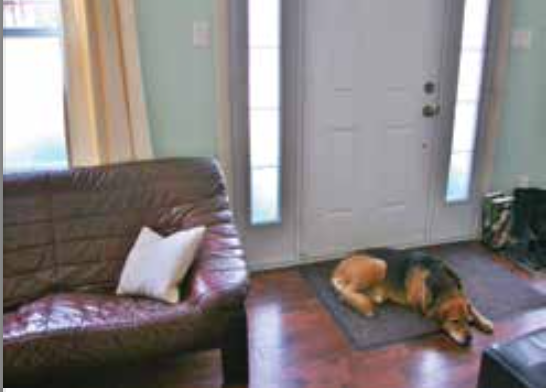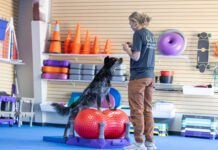
Many dog owners routinely leave their dogs home alone without giving it a second thought. They put on their shoes, grab their coat and keys, tell the dog “See you later!” – and off they go.
Some of us need to put a little more thought into our departures for various reasons. Special arrangements might be necessary to accommodate a puppy, a curious adolescent, or multiple dogs (or dogs and cats) who are safest if they’re separated when the humans are out. The right setup is particularly critical for dogs who experience distress when isolated (often referred to as “separation anxiety”), as they can be destructive to their environment and themselves.
But perhaps you are just planning to get a new dog or puppy and are fretting about how or whether you can leave her home alone when you go to work or school. No matter what type of dog you have (or will have), thoughtfully setting up a designated space for your dog will maximize her ability to relax when she’s home alone.
WHAT’S YOUR DOG’S MOST COMFORTABLE SPOT?
For many dogs, leaving them loose in the home is just not an option, as they get into all kinds of shenanigans, especially if they’re young. This is where you can get creative with the use of barriers such as baby gates or even some crafty home-made solutions. You might need to do some experimenting to see what works best for your dog (see “Creative Confinement,” WDJ March 2022).
Most people tend to choose a location in the home that’s convenient for them (the owner), and then they’ll work really hard to try to help their dog learn to like that area, or to feel comfortable in it.
Instead of choosing a location that’s most convenient for me, I prefer to begin by identifying the dog’s favorite spots. Where does she feel most comfortable? Where does she like to hang out and nap? That’s where your dog should be taught to spend time when she’s alone, whether it’s a crate, a room, or a large open space that you block off somehow.
You may have heard that a crate is like a dog’s “natural den,” providing a dog with an enclosed environment will stir innate feelings of safety and security.
In reality, dogs don’t live in dens on a regular basis. In feral dog communities, a den is a location away from the usual resting places, where females birth and care for their puppies. Adolescent and adult feral dogs don’t live in dens. And consider this: Even those animals that are den animals are never actually confined to the den. They don’t get locked in; they can exit whenever they choose.
Comfort in crates is an individual matter. Some dogs love their crates and seek them out when they are tired or stressed. In contrast, some dogs who show anxious behaviors when they’re crated do a whole lot better when they’re not confined. In other words, being left home alone isn’t the problem, confinement is. They’re able to relax if left loose in the home.
One thing is absolutely certain: If your dog regularly panics inside a crate, bending metal bars or chewing through plastic, that crate is doing far more harm than good, and I recommend you put it away and consider other confinement solutions.
ACCLIMATING TO THE SPACE
If you’re thinking about using a space in your home where your dog has never before hung out, or maybe a room or a section of your home that she’s not really familiar with, start by building a positive association with that location. Begin feeding your dog her meals there, completely unconfined, with no barriers or closed doors. Spend some quiet time there with your dog. Let her work on a food toy, chew on a bone, or nap while you sit close by and work on your laptop, read a magazine, or engage in whatever quiet activity you want.
In order for a new space to become familiar, a place where your dog will be able to fully relax, spend a lot of time there creating this positive association. This won’t happen overnight, or even in a week. It’s going to take some time; it can’t be rushed.
I went through this process myself with my own dog Bennigan when he was just a puppy. He was too young to be left loose in the house, but he was terribly claustrophobic and couldn’t comfortably be confined in a crate. I chose the entire dining room as his home-alone area, but it needed to be enclosed for his safety. I installed a baby gate separating the kitchen from the dining room (which I still use for management purposes). I have French doors that separate the dining room from the living room. Under normal circumstances, these doors are open. But during training, it was important that these doors were closed now and then so that Bennigan could get used to seeing them closed.
Bennigan has a large bed in the dining room that he loves and uses regularly. This is partly why I had chosen the dining room as his home-alone space, because I was confident that he already enjoyed relaxing in this room. If you currently use a crate with your dog and she really loves to spend time in it, consider placing it in a larger enclosed space and leave the crate door open for her to snooze in it if she chooses to.
During my practice sessions with Bennigan in the enclosed dining room, I’d give him an interactive food toy like some kibble in a snuffle mat or I’d smear something yummy on a Lickimat. While he was busy with that, I’d work on my laptop at the dining room table for a while. We’d spend time quietly in the room together, but not interacting. These practice sessions helped to acclimate him to the enclosed dining room before I ever left him alone in there.
HOME-ALONE AMBIANCE
Making sure that things feel normal, safe, and familiar when your dog is left alone involves more than just a prime location. Pay attention to the overall ambiance, too. But consider this: Creating a comforting ambiance for your dog while he’s home alone has less to do with trying to create what we think is a relaxing setting and more to do with retaining a sense of normalcy within his environment.
When you leave your home, does it create a stark contrast to when you were there just moments before? Does the level of noise and activity generated by your presence suddenly drop to nothing? Think about what a typical morning scene might sound like in your home. There might be clanking dishes and cutlery, running tap water, cupboard doors and drawers opening and closing, footsteps, floor creaks, door latches, TV or radio commercials, and conversations. And then suddenly, when everyone is gone, all that’s left is silence. The contrast may be unnerving to your dog.
Try to notice what types of sounds are “normal” in your dog’s home environment. Can you safely leave some of those sounds behind when you step out? Some appliances shouldn’t be operating when we’re not home, such as the washing machine or the dryer. But how about the radio? Is there usually a ceiling fan spinning and whirring when you’re home?
People often advise leaving the TV on for your dog. But would the TV be on if you were home? If not, and you’re turning it on only when you leave, you’re not really imitating the true sounds of when you’re home. If the TV is usually on when you’re home, then by all means, go ahead and leave it on. Be mindful, however, of sounds that might upset or excite your dog, like doorbells or dogs barking during commercials. Maybe a cable movie channel, or a continuous source of music without commercials, might be best in this case. Be mindful of the volume, though. Dogs’ ears are more sensitive than ours, and a low volume will do just fine.
For dogs who become stressed by outside noises, any sound or white noise that you can leave inside your home will help to mask the outside noises and can prevent your dog from becoming frightened or excited. White noise machines produce sound that contains equal amounts of all frequencies audible to the human ear. Some offer a variety of “colored” noises, including brown noise (which contains more lower-frequency sounds) and pink noise (which sits somewhere between brown and white noise). With their predominant lower frequencies, pink and brown noise are better for masking outdoor noises. These inexpensive machines can be purchased online.
ROOM WITH A VIEW?
The last element to consider depends on whether or not your dog is a window patroller. While some dogs are able to just casually look outside and remain calm, dogs who are prone to feeling stressed or anxious tend to do more than just enjoy the view. These dogs might feel a sense of obligation to “patrol” what happens outside the window. They stay vigilant the entire time you’re gone. That takes a lot of mental energy! And it can create far more stress than you think.
If this is your dog, I recommend obstructing her view to the outside. Consider installing frosted window film that allows daylight to stream in but blurs the view to outside. Get the non-adhesive type that you can easily remove whenever you like without damaging the window or being left with sticky residue on the glass. It’s very easy to install with some soapy water in a spray bottle and an item with a hard edge, like a bank card.
If your dog likes to hang out next to a window and gaze out, do a few tests by blocking her view to see if she really “enjoys” it, or if she’s actually calmer if she can’t see what’s happening out there. You might be surprised to learn that your dog is grateful to finally be retired from window patrol! She might actually sleep if she can’t see outside.





My pet 🐶 sleep at night 🌉, but I normally leave the radio on down low and a rotating fan position by her fav chair. Samson is 2 yr young Lab mix.
My 4 paws loves her crate at home and outside. Problem is at trials or training, really hates being in it. Even if we are with her. Tried everything. Any suggestions.
I leave my dog with a sweet music at night with a fan rotating on him. This provide better sleep to my dog 💕
I’m moving in 1 week. Chaotic, to say the least. My little rescue, who’s been with me a bit over 2 years, and I will be adjusting to a whole new life.
Confining is tricky since the house is quite open. Large doorways.
I’m so tired of barricading LR & DR here, to keep her off rugs. I have Saltillo tile..so gross but cleanable.
My new house has $$$$$ new wood floors. NOT wanting urine on them!
AND..we’re “back to square one” on indoor potty behavior. She came to me “almost” pee pad trained, which is code for not at all.
I have consistently encouraged both pad & outside as the only 2 acceptable places.
In this ‘hood, being out at night was not an option.
Pee pads seemed like a good idea! 🤦♀️
Now she’s missing entirely, edge peeing and seemingly acting out by pooping/peeing when anyone enters the home.
Finding a good spot for alone confinement, doesn’t mention what to do about bathroom habits when confined in that space!
And yes! I DO make the mistake of playing music when I leave our rather quiet home..she knows why gets quite anxious.
I’m not sure how to figure any of this out.
I realize I’ve rambled.
This turmoil is not good for either of us.
Thx for great advice!